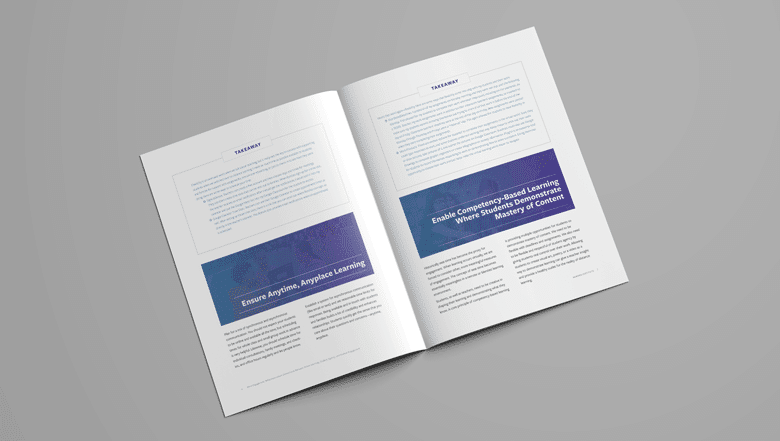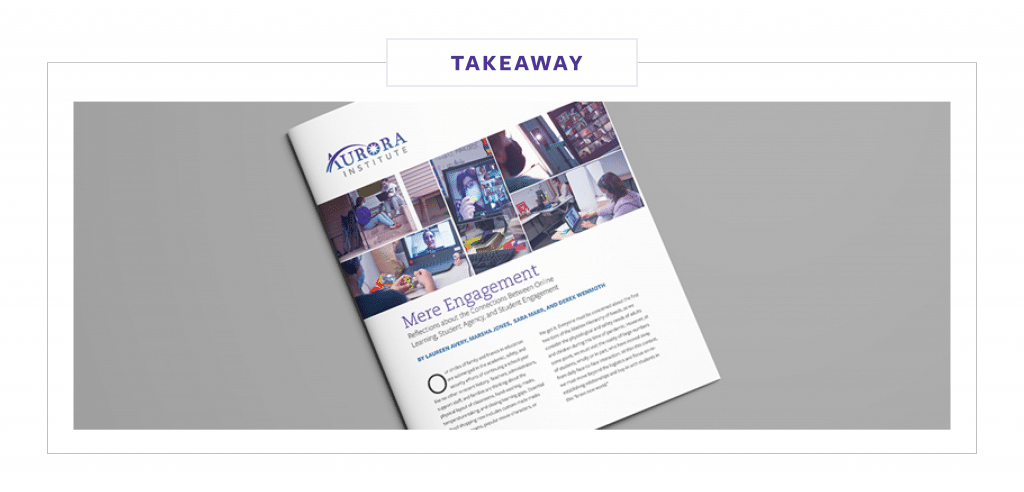Ensure Anytime, Anyplace Learning and Enable Competency-Based Learning in Distance Learning
Education Domain Blog

This is the third in a series of blog posts presenting our latest issue brief, Mere Engagement: Reflections about the Connections Between Online Learning, Student Agency, and Student Engagement. Find the first post here and the second post here.
Ensure Anytime, Anyplace Learning
Plan for a mix of synchronous and asynchronous communication. You should not expect your students to be online and available all the time, but scheduling times for whole class and small group work in advance is very helpful. Likewise, you should schedule time for individual consultations, family meetings, and check-ins, and office hours regularly and let people know. Establish a system for asynchronous communication (like email or text) and set reasonable time limits for responses. Being available and in touch with students and families builds a lot of credibility and enhances relationships. Students quickly get the sense that you care about their questions and concerns – anytime, anyplace.

Here’s that word again—flexibility. Here are some ways that flexibility came into play with my students and their work:
- Due Dates/Deadlines. I posted all of my assignments on Monday morning, and they were not due until the following Monday. This allowed for my students to complete their work whenever they could, including on the weekends. As a TESOL Teacher, my work assignments were in addition to their classroom teachers’ assignments, so I wanted to make sure my students weren’t stressing themselves out trying to cram all of that work in before the end of the day on Friday. Classroom teachers’ deadlines were at the end of the day on Friday. New assignments were posted Monday through Thursday, and Fridays were a “make-up” day. This again allowed for students to have flexibility in when they were completing their assignments.
- Work Products. There are endless options for students’ to complete their assignments in the virtual world. Sure, they could type responses to work, and some students preferred working that way. Many chose to write out their work or draw pictures, take pictures of it, and submit the pictures on Google Classroom. Students could also use Google Drawings to complete graphic organizers or create infographics to convey information. Flipgrid is an awesome tool for students to record themselves responding to work or demonstrating how to solve a problem. Giving them the opportunity to choose their work product helps make the virtual learning world easier to navigate.
Historically seat-time has become the proxy for engagement. When learning occurs virtually, we are forced to consider other, more meaningful measures of engagement. The concept of seat-time becomes essentially meaningless in a remote or blended learning environment.
Students, as well as teachers, need to be creative in shaping their learning and demonstrating what they know. A core principle of competency-based learning is providing multiple opportunities for students to demonstrate mastery of content. We need to be flexible with deadlines and assignments. We also need to be flexible and respectful of student agency by giving students real control over their work. Allowing students to create visual art, poetry, or a video as a way to demonstrate learning can give a teacher insight and provide a healthy outlet for the reality of distance learning.
Students who do not turn in work as expected may be impacted by an internet cut-off due to lack of payment, a little brother who dropped the cell phone into the bathtub, a dad who went out of town and took his computer with him, and so on. We can’t assume that the assignment was clear, the materials were available or that the student knew how to secure help to complete the assignment.
Laureen Avery is the director of the UCLA Center X Northeast Region office and focuses her work on supporting classroom teachers working with English learners through the ExcEL Leadership Academy. Marsha Jones, was formerly the associate superintendent for curriculum and instruction with Springdale Public Schools and is presently an adjunct professor at the University of Arkansas. Sara Marr is a TESOL teacher and ExcEL coach at the Shelton Public Schools. Derek Wenmoth was until recently a director of CORE Education, a not-for-profit education research and development organization in New Zealand. He is now working independently as an education consultant.